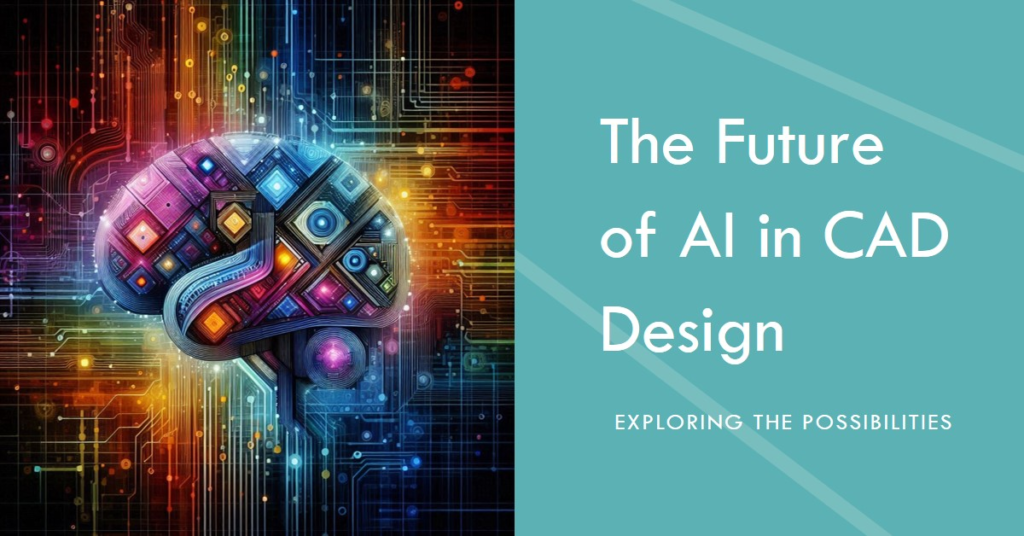Introduction to Artificial Intelligence CAD Design
Artificial Intelligence CAD design is at the forefront of the design industry. It is changing the field with its automation and innovation. AI can automate repetitive tasks in CAD systems. It boosts accuracy, sparks innovation, and streamlines design workflows. Streamlined workflows spark innovation, yielding groundbreaking answers and pushing limits. Creative sparks ignite when teams function in harmony. Streamlined processes unleash innovation, pushing boundaries and charting unexplored territories. By optimizing workflow, groups transcend limitations and forge groundbreaking paths forward.

How Artificial Intelligence Is Enhancing CAD Design
Automation and Efficiency
Artificial Intelligence CAD design boosts efficiency by automating simple tasks. This allows designers to tackle more complex project parts. So, the design process speeds up and human error decreases, enhancing precision. AI systems evolve, honing their skills through data analysis. With each iteration, they grow smarter and more capable. Their performance improves.
Generative Design Capabilities
AI-powered generative design offers vast creative possibilities. It helps designers explore many options and solutions in a short amount of time. Algorithms create design options within specific limits. Designers can then pick the best one. This ability fosters innovation. It provides solutions that are not obvious through traditional methods.
Predictive Analysis for Accurate Designs
AI’s predictive analysis in Artificial Intelligence CAD design finds potential issues early. This allows for fixes before they become costly problems. This is especially helpful in high-precision fields, like aerospace and automotive. Design flaws vanish under AI’s watchful eye. The result? Products that achieve every mark by meeting specifications and standards without any errors.
Collaborative Design Processes
Artificial Intelligence CAD design improves design team collaboration with real-time updates and insights. It ensures that all stakeholders align and stay informed. This is crucial to the successful completion of complex projects. Collaborative AI enhances team efficiency. Smart tools streamline design sharing and critique, boosting output.
Benefits of Artificial Intelligence in CAD Design
- Increased Productivity: Automating routine tasks lets designers spend more time on creative design. This boosts productivity.
- AI algorithms analyze vast data to ensure designs are precise and error-free. This is vital in precision-focused industries.
- Cost Efficiency: Artificial Intelligence CAD design cuts manual labor and errors. This saves money and makes it a cost-effective choice.
- AI-driven generative design boosts innovative thinking and creativity. It pushes the limits of traditional design.

Future Prospects of AI in CAD Design
The future of Artificial Intelligence CAD design is promising. Machine learning and data analytics are advancing fast. AI’s growth sparks a design revolution. Creativity soars. Efficiency skyrockets. Precision sharpens. Better tools emerge, transforming the creative landscape. Designers harness new powers, pushing boundaries further than ever before. Integration with Augmented Reality.
Artificial Intelligence CAD design systems will likely integrate with AR technologies. This will give designers immersive design experiences. This will enable a more interactive design process. It will be easier to visualize and change designs in real time.
Focus on Sustainability
AI can help create sustainable designs. It can optimize material and energy use. This aligns with global sustainability goals. Focusing on sustainability will help the environment. Supporting green initiatives improves the reputation of eco-friendly companies. Their market position strengthens as they champion environmental causes. This earns respect and admiration from consumers and industry peers alike.
Personalized Design Solutions
Artificial Intelligence CAD design algorithms can analyze user behavior and preferences. Customized designs boost client satisfaction, fostering loyalty. Custom-fit answers meet specific demands, boosting loyalty and client satisfaction. Tailored experiences drive loyalty, satisfaction, and revenue. Customers return when brands cater to their unique needs.
Conclusion
AI-powered CAD combines automation, precision, and ingenuity. It is a reshaping design. Creators and engineers are racing ahead. They are using new tech that sparks fresh possibilities and changes industries. As AI evolves, it will impact design. This will spark innovation and boost efficiency. This tech leap will revolutionize creativity and design. It will streamline workflows and unlock new possibilities. Forward-thinking professionals are embracing AI tools. They are at the forefront of a design revolution.
FAQs
Q1: How does AI improve CAD design accuracy?
Artificial Intelligence CAD design analyzes data to identify patterns and predict design flaws, ensuring accuracy.
Q2: What is generative design in AI-powered CAD?
AI algorithms create many design options within set limits, sparking innovation.
Q3: Can AI in CAD design reduce costs?
AI reduces costs by automating tasks and minimizing errors.
Q4: What is the future of AI in CAD design?
Future plans include augmented reality, sustainable design, and personalization, powered by AI advancements.
